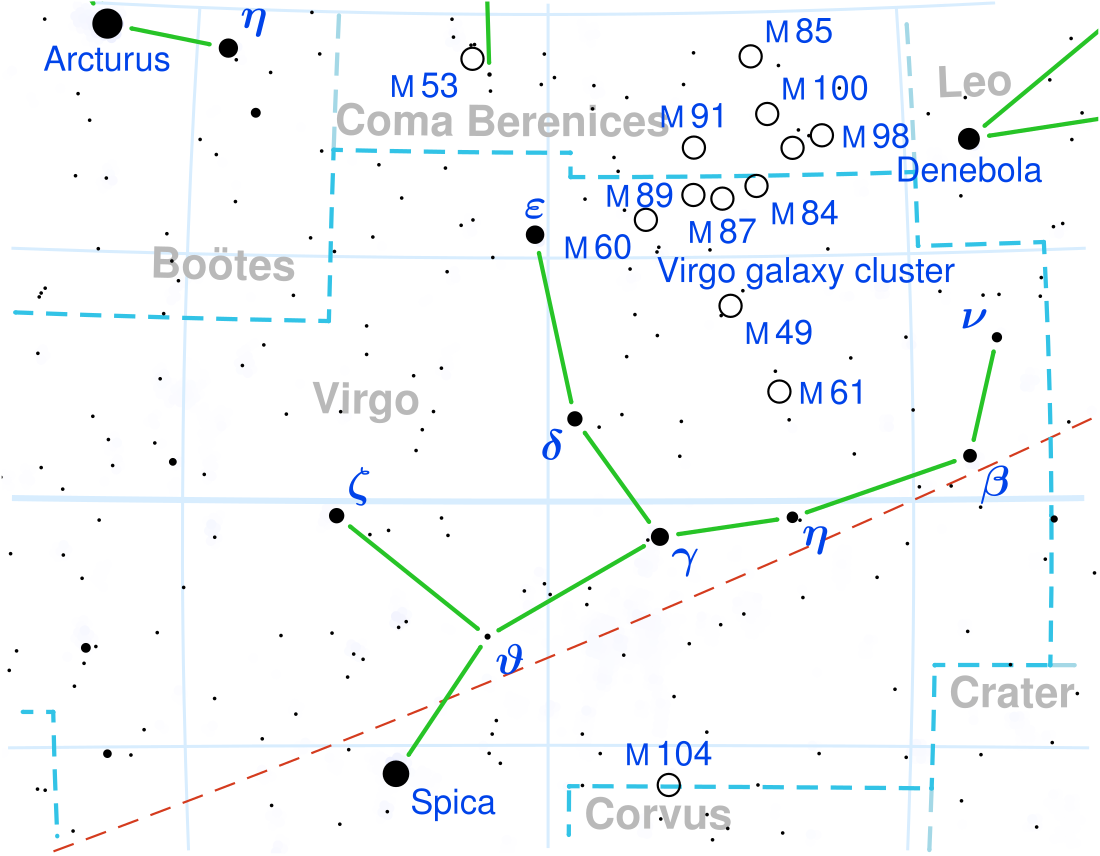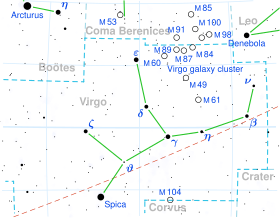Top Qs
Timeline
Chat
Perspective
Gamma Virginis
Star in the constellation Virgo From Wikipedia, the free encyclopedia
Remove ads
Gamma Virginis (γ Virginis, abbreviated Gamma Vir, γ Vir), officially named Porrima /ˈpɒrɪmə/,[12][13] is a binary star system in the constellation of Virgo. It consists of two almost identical main sequence stars at a distance of about 38 light-years.
Remove ads
Name
Summarize
Perspective
γ Virginis (Latinised to Gamma Virginis) is the star's Bayer designation.
The traditional name Porrima derives from Ancient Rome: Porrima, also known as Antevorta, was one of the Camenae or goddesses of prophecy.[14] In 2016, the International Astronomical Union organized a Working Group on Star Names (WGSN)[15] to catalog and standardize proper names for stars. The WGSN's first bulletin of July 2016[16] included a table of the first two batches of names approved by the WGSN; which included Porrima for this star.
In the catalogue of stars in the Calendarium of Al Achsasi Al Mouakket, this star was designated Laouiyet al Aoua, which was translated into Latin as Angulus Latratoris, meaning 'the angle of the barker'.[17] This star, along with Beta Virginis (Zavijava), Eta Virginis (Zaniah), Delta Virginis (Minelauva) and Epsilon Virginis (Vindemiatrix), were Al ʽAwwāʼ, the Barker.[14]
In Chinese, 太微左垣 (Tài Wēi Zuǒ Yuán), meaning Left Wall of Supreme Palace Enclosure, refers to an asterism consisting of Gamma Virginis, Eta Virginis, Delta Virginis, Epsilon Virginis and Alpha Comae Berenices.[18] Consequently, the Chinese name for Gamma Virginis itself is 太微左垣二 (Tài Wēi Zuǒ Yuán èr, English: the Second Star of Left Wall of Supreme Palace Enclosure.),[19] representing 東上相 (Dōngshǎngxiāng), meaning The First Eastern Minister.[20] 東上相 (Dōngshǎngxiāng), westernized into Shang Seang by R. H. Allen and the meaning is "the High Minister of State".[14]
Remove ads
Properties
Gamma Virginis is a binary star, consisting of two stars of nearly equal apparent magnitudes 3.65 and 3.56, and of spectral type F0V.[2] With an orbital period of 168.93 years,[21][6] it was an easy object for amateur astronomers until the beginning of the 1990s, but in 2011 the smaller apparent distance between the stars requires a larger telescope or special techniques such as speckle interferometry,[21][6] adaptive optics[22] or optical interferometry[23] to resolve the individual components. The last time they were at periapsis was in 1836. The distance became wide enough in 2020 to view with a small telescope. The star system has a combined apparent magnitude of 2.9. The system is 39 light-years away from the Sun.
Gamma Virginis has been reported to be slightly variable,[24] but this is now considered unlikely.[3]
At 2.8 degrees north of the ecliptic, Gamma Virginis it can be occulted by the Moon and (rarely) by planets. In June 2011 Saturn passed a quarter of a degree south of Porrima.
Based upon X-ray emissions—an indicator of the strength of the stellar magnetic field—this system has an estimated age of 1.14 billion years.[25]
Remove ads
Changes of distance and position angle
This table shows the apparent distance between the two stars and their relative position angle: the first three columns show data predicted from an orbit calculated in 1937, the next two columns show in 2006,[26] the next three columns show observations reported by the Hanwell Community Observatory.[27]
References
Wikiwand - on
Seamless Wikipedia browsing. On steroids.
Remove ads

